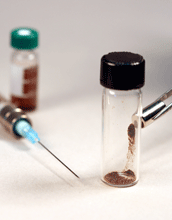Multimedia Gallery
Smart Dust Photonic Crystal
Magnetic porous silicon, "smart dust" photonic crystal particles in a vial. These particles, each roughly the size of a human hair, can be used in applications in environmental sensing, biosensing, drug delivery or high-throughput screening for new drugs or genetic markers for disease.
More about this Image
The ability of molecules to navigate between membranes is key to many biological processes. For example, the transport of drugs across cell membranes often determines their efficacy. The objective of a National Science Foundation (NSF)-supported research project, headed by Michael Sailor, a professor of chemistry and biochemistry and professor of bioengineering at the University of California, San Diego, is to build artificial nanostructures to enable the study of the motion and concentration of molecules across interfaces, and to develop means to trap and release drug molecules within a nanostructure. The project is investigating the parameters that allow for the loading and slow release of drugs under appropriate physiological conditions. The work encompasses new methods of trapping molecules into porous nanostructures and new methods of monitoring porous nanostructures using the optical properties of the materials.
The project is being conducted in collaboration with partners Frederique Cunin, Bernard Coq and Jean-Marie Devoisselle of the National Center for Scientific Research (CNRS) Institute Charles Gerhardt in Montpellier, France. The Montpellier lab has played a major role in the development and commercialization of liposome-based drug delivery materials in France, and a previous NSF-funded collaborative project expanded the breadth of this effort significantly. The drug delivery and pharmaceutical characterization expertise of the Montpellier group combines with the nanomaterials design and optics expertise of the Sailor research group. The project features the exchange of students between the two labs for durations of two to four months each year. (Date of Image: March 2008) [Research supported by NSF grant DMR 08-06859.]
Credit: Courtesy Michael J. Sailor and Elizabeth Wu, UCSD
Images and other media in the National Science Foundation Multimedia Gallery are available for use in print and electronic material by NSF employees, members of the media, university staff, teachers and the general public. All media in the gallery are intended for personal, educational and nonprofit/non-commercial use only.
Images credited to the National Science Foundation, a federal agency, are in the public domain. The images were created by employees of the United States Government as part of their official duties or prepared by contractors as "works for hire" for NSF. You may freely use NSF-credited images and, at your discretion, credit NSF with a "Courtesy: National Science Foundation" notation.
Additional information about general usage can be found in Conditions.
Also Available:
Download the high-resolution JPG version of the image. (2.1 MB)
Use your mouse to right-click (Mac users may need to Ctrl-click) the link above and choose the option that will save the file or target to your computer.



